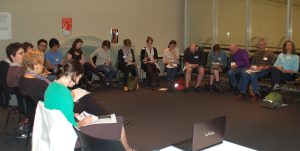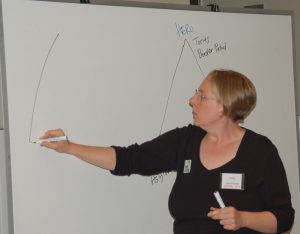 The Melbourne Campaigners’ Network got off to a great start last Thursday with the first gathering attracting a diverse group of over twenty activists, campaigners and organisers.
The Melbourne Campaigners’ Network got off to a great start last Thursday with the first gathering attracting a diverse group of over twenty activists, campaigners and organisers.
The focus of the night was an introduction to story-based strategy. We ran through some of the key terms used by US strategists smartMeme as part of their story-based strategy campaign model, and discussed how this applied to Australian examples.
Story-Based Strategy — A framework that links movement building with an analysis of narrative power and places storytelling at the centre of social change strategy. The framework provides tools to craft more effective social change stories, challenge assumptions, intervene in prevailing cultural narratives, and change the story around an issue.
 We talked about the difference between truth and meaning. Activists often put a lot of emphasis on gathering facts, data, and evidence for their positions. There’s value in this, but we can overlook the barriers to people understanding the information we distribute. We assume that because something is factually true it will have meaning for people. Actually, if a story is meaningful to people, they will believe it to be true. The pre-existing narratives through which people understand the world will shape whether they believe our messages. Campaigning that uses the power of narrative develops compelling stories which, although they may challenge underlying assumptions, are accessible to people and can be understood.
We talked about the difference between truth and meaning. Activists often put a lot of emphasis on gathering facts, data, and evidence for their positions. There’s value in this, but we can overlook the barriers to people understanding the information we distribute. We assume that because something is factually true it will have meaning for people. Actually, if a story is meaningful to people, they will believe it to be true. The pre-existing narratives through which people understand the world will shape whether they believe our messages. Campaigning that uses the power of narrative develops compelling stories which, although they may challenge underlying assumptions, are accessible to people and can be understood.
Looking at how the other side of politics engages with story can be illuminating. Here’s one picture worth a thousand words.
 This anti-carbon tax protester manages to evoke Pinocchio (the more you lie, the longer your nose will grow) as well as witchcraft (a persistent cultural story about untrustworthy women) and schoolyard morality (liar, liar, pants on fire). The Juliar meme, first coined on shock-jock radio, has spread virally and has become part of the story about the Prime Minister, such that there is very little analysis or debate about whether she actually lied or not. A recent article by Peter Lewis on The Drum unpacks the ‘Juliar phenomenon’.
This anti-carbon tax protester manages to evoke Pinocchio (the more you lie, the longer your nose will grow) as well as witchcraft (a persistent cultural story about untrustworthy women) and schoolyard morality (liar, liar, pants on fire). The Juliar meme, first coined on shock-jock radio, has spread virally and has become part of the story about the Prime Minister, such that there is very little analysis or debate about whether she actually lied or not. A recent article by Peter Lewis on The Drum unpacks the ‘Juliar phenomenon’.
Meme — A unit of self-replicating cultural information (i.e. idea, slogan, melody, ritual, symbol) that spreads virally from imagination to imagination and generation to generation. SmartMeme defines a meme as a container, capsule, or carrier for a story to spread.
I’ve come across some resistance from progressives when it comes to strategic use of communications. I think this comes in part from a dislike of ‘spin’ and the dishonest practices of those on the right-wing. Story-based strategy is not about lying – it is about reducing the barriers to communication, and growing political opportunity in the narrative sphere. If the right keeps coming up with ‘capsules’ to spread their story virally, while we rely on long reports and media statements which use complicated scientific language, we allow them to have it all their own way.
Frame — The larger story that shapes understanding of information, experiences, and messages; the structure and boundaries of a narrative that defines point of view and power. Frames operate as pre-existing narrative lenses in our minds.
Over dinner afterwards a few of us starting to discuss the question ‘Who is doing this well?’ That is, who is using story-based strategy approaches which:
- Frame the Conflict
- Amplify the Voices of Impacted Characters
- Use Imagery – Showing rather than Telling
- Engage People’s Values
- Foreshadow – Show the Future, Offer Vision
- Challenge Assumptions
Here are some of the examples we came up with over dinner, and subsequently.
- We are the 99% – Occupy Wall Street has spread to become a worldwide movement and #occupy is a meme in its own right. Another very effective meme that has been born from this movement is ‘We are the 99%’. This meme is a capsule for a story about wealth inequality. Globally the richest 1% own 40% of the world’s wealth. In the US the top 1% annually takes nearly a quarter of the nation’s income. The Occupy movement is the latest of many struggles focused on the economy and fair share of resources. However, the focus on the 1% frames the conflict and brings into the spotlight those who benefit from and perpetrate the current economic system. The 99% meme builds unity and groups together a broad range of concerns. It also makes a strong link between the economy and democracy – how can the world be set up for the benefit of just 1% of people?
- Don’t Risk Coal Seam Gas – Often the battle of the story includes competition over characters, and whose interests those characters represent. This tension is present in the debate around coal seam gas, with farmers and other members of rural communities being used in the story-telling on both sides. Rowan Dean, an advertising creative director and occasional Gruen panellist, contrasted the advertisements of the pro and anti CSG groups in a recent piece in the Sydney Morning Herald. The GetUp! and Lock the Gate Don’t Risk CSG ad uses authentic characters who are directly impacted by CSG, and footage of the environment affected. The ‘We Want CSG’ ads are less convincing, do not use the names of characters, and to quote Dean, ‘self-interest and evasiveness appear to be the order of the day’. In another twist in the battle of the story, the Australian Parody Production & Exploration Association Ltd has launched the ‘Who Wants CSG?’ website as a Yes Men style piece of identity correction.
- United Voice – United Voice consistently amplifies the voices of impacted characters by ensuring that workers are front and centre. Affected workers speak in the media, at rallies, in meetings with employers, and to government committees. Worker’s stories are frequently shared to both illustrate the problem and build the sense of the value of collective action. United Voice was formerly known as the LHMU, and is the union for workers in a wide range of occupations including hospitality, property services, health & aged care, manufacturing, mining & miscellaneous and childcare. For an example of the unions work see the Hotels With Heart campaign.
- Make History Melbourne – The successful Greens campaign to elect Adam Bandt to the seat of Melbourne, supported by communications agency Make Believe, engaged with narrative in a more extensive way than the usual electoral campaign. Voters themselves were cast as characters central to the story – ‘your vote is powerful’. The slogan ‘Make History Melbourne’ foreshadowed success. The campaign’s rhetoric was borne out in the actual election result – not just electing the first Green to the House of Representatives at a general election, but also playing a key role in allowing the ALP to form government.
See Doyle Canning and Patrick Reinsborough’s Re:Imagining Change book, available from Plan to Win, for more comprehensive case studies of how campaigns have intervened to change the story. Got more examples? Please share!
Where to from here?
This session at the Melbourne Campaigners’ Network offered a brief introduction to story-based strategy. If you would like to talk more about how the story-based strategy approach and planning tools can improve the effectiveness of your campaign, get in touch. A public workshop with diverse participation is planned for the new year, but campaign-specific workshops can also be organised.
The Melbourne Campaigners’ Network is back on Wednesday 2 November. Tim Norton, Oxfam Australia Digital Campaigns Coordinator, will present ‘Taking a Campaign Online’. The session will outline how to choose your target and which digitals tools most effectively engage your supporters and achieve your aims. Register here.
Thanks to everyone who helped out on the night, and contributed to such an interesting discussion. See you next time!
Definitions from smartMeme‘s ‘Definitions of Core Concepts’. Creative Commons Licence: Attribution, NonCommercial, ShareAlike.
